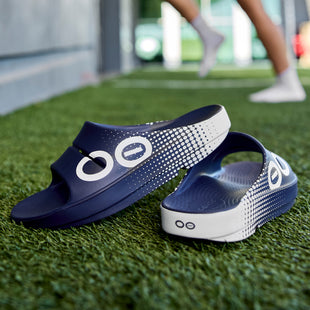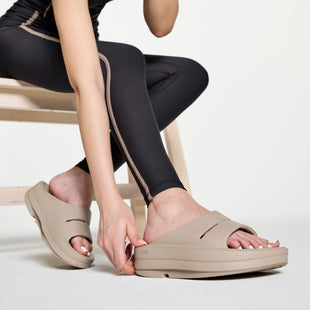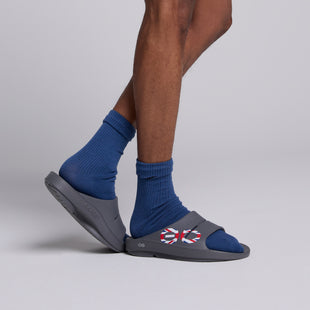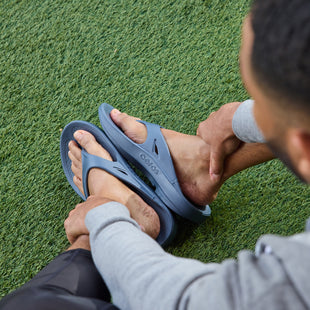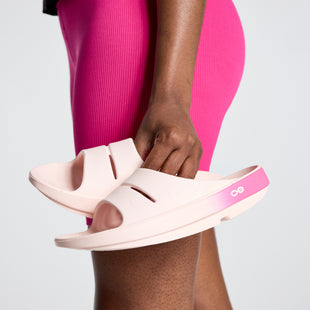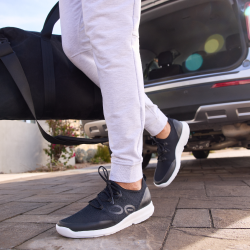As a physiotherapist, one of the most common causes of injury I come across is overtraining and not recovering adequately post-exercise. Many athletes feel guilty when they take a break, but building in recovery days into the training schedule can, in fact, promote soft tissue adaptation, improve performance and reduce risk of injuries.
Optimal recovery is essential after any athletic endeavour, especially if you’ve completed any endurance-type exercises such as running a full marathon. When the hard work is over, it is easy to turn your attention to resting and overlook the important process of recovery. Our body experiences major physiological changes as a result of a 26.2 mile race. It is vital to replenish it and repair muscle tissues that have undergone a huge amount of stress. In this article, I will explain 5 key tips on how to maximise recovery when training for, or after running the London Marathon.

5 essential tips to enhance pre and post-marathon recovery
Tip 1: Focus on mobility
Mobility exercises are also commonly prescribed as part of the active recovery routine to improve range of movement and reduce muscle tension. Low-intensity exercise following a strenuous race is often considered to be more beneficial than inactivity/complete resting. Simply spending around 15 minutes a day pre and post-marathon can make a significant impact on your recovery. Here are 3 of my go-to mobility exercises:
Modified Hamstring Rock: This dynamic exercise primarily stretches the hamstrings along with the opposing hip flexors. Both muscle groups are heavily used in marathon running and will benefit greatly from this drill.
- Start at a lunging position with back (right) knee touching the floor.
- Shift your bodyweight to your front (left) leg until you feel a stretch at the front of your opposite hip.
- Shift your bodyweight back to your back leg and straighten your front knee. During this movement, slowly lean your trunk towards the front leg. You should feel a stretch in the back of your left thigh.
- Hold for 5-10 seconds at each position and perform 10-15 repetitions on each leg. Complete 4-5 times a week.
90/90 Hip Rotations: This stretch combines both hip internal and external rotations in one movement. It improves gluteal muscle imbalances in deep gluteal muscles and reduces hip joint capsule stiffness.
- Sit on the floor. Rotate your left hip outwards, with knee bent at 90-degree. Rotate your right hip inwards such that it forms a 90-degree angle with your left hip, bending your right knee until they reach 90-degree as well. Both ankles should be at a neutral position.
- Keeping your back straight (using your hands as support against the floor if needed and rotate your hips such that both knees point at opposite sides.
- Perform 10-15 repetitions of the above, alternating between left and right positions and holding at each position for 5 seconds. Complete 4-5 times a week.
Dynamic Calf Stretch: Our calf complex takes up to 4-8 times our body weight when running and are usually one of the sorest areas post-marathon. Most stretches bias either the soleus or gastrocnemius aspect of the calf complex, but this exercise can target both of them.
- Get into a plank position with hands and feet shoulder apart on the floor.
- Walk your hands backwards until your body forms a triangle.
- Bring your right knee up and lift your right heel off the floor while shifting your weight onto the left foot which is planted on the floor. You should feel a stretch on your left calf.
- Hold that position for 5-10 seconds and alternate the stretch on the right calf.
- Perform 10-15 repetitions on each leg and complete this sequence 4-5 times a week.
Tip 2: Fuel and refuel
The body’s two primary energy sources for physical activity are carbohydrates and fat. Given the chance, it will burn the former option first. In order to start the race with optimal carbohydrate stores (glycogen), have a carbohydrate-rich diet 32-48 hours leading up to the race - also known as carb-loading. After the race, these depleted glycogen stores need to be topped up. In addition to that, consuming high-quality protein is also recommended to repair damaged muscle tissues. The body’s ability to refuel usually is at its peak within 30-60 mins post-race.
Tip 3: Take a break
26.2 miles put an enormous strain on the body both physically and mentally. Take around 7-10 days off from running to allow your body and mind to heal (‘skeletal reset’). Take 30-40 minute naps and get 8-10 hours of sleep for the next few days. Taking a short break from running will have little negative impact on your current fitness. The fitness you have built up over the past few months will stay with you and will contribute to an ever better foundation for your next training regime. Allow yourself to catch up on some quality time with friends and family, or activities you’d put on hold due to the intense training regime.
Tip 4: Wear recovery slides on the go
Delayed-onset muscle soreness (DOMS) will develop within 12 hours post-marathon and can last for 5-10 days. You will feel aches from muscles you didn’t even know existed! Although it may feel like the last thing you want to do, try not to stay in bed or sit around for too long. Go for short 10-15 minute walks, bike rides or swim to improve blood circulation to tired muscles and joints. As you feel better, you may begin doing some easy jogs with walking intervals.
A recovery tool I have recently introduced post-training is sports recovery footwear by OOFOS. Each pair is made from the brand’s proprietary OOfoamTM technology that absorbs 37% more impact than traditional footwear and significantly reduces stress on the joints. Its footbed design cradles and supports the arches which allows pressure to be more evenly distributed across your foot. They have been proven to reduce compressive forces in the knees while also reducing energy exertion in the ankles by up to 20%. I feel like I’m walking on clouds whenever I wear them, it’s a complete game-changer! Post-training I slip on my OOahh sandals, and when out and about I wear the OOcandoo shoe.
Tip 5: Treat yourself to a massage
Consider treating yourself to a well-deserved sports massage after an outstanding achievement! This can help reduce muscle soreness and tension via a cascade of neurophysiological responses from the peripheral and central nervous system. Self-massage techniques using foam rollers, ice/ warm baths are also popular alternatives.
Plan ahead to rebound quicker after running 26.2 miles
While the hard work from training and racing may be over, there is still work to be done. If you wish to rebound quicker after the race, an extensive recovery plan is paramount. Plan ahead of time and ensure you recuperate physically and mentally post-race. This way, you can celebrate your achievement while making sure your body returns to optimal condition to reduce risk of injury and prepare for your next training regime.
Respect that your body needs time to recover from lingering fatigue and sore muscles, but if you are still experiencing pain and discomfort that doesn’t seem to subside, feel free to book a consultation with me for any physiotherapy advice.

